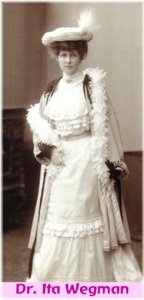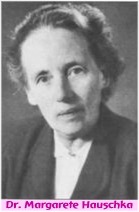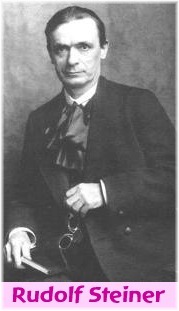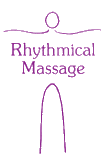|





| |
What is Rhythmical Massage?
 Rhythmical
Massage strives to restore harmony in the individual by overcoming imbalances
caused by stress and illness. It supports the process of healing and aids in the
prevention of illness by working with life sustaining processes such as warmth,
rhythm, and breathing. The gentle rhythmic quality of touch, which is central to
the massage, penetrates deeply. Rhythmical massage works with levity instead of
gravity harmonizing the bodily rhythms of the individual. Rhythmical
Massage strives to restore harmony in the individual by overcoming imbalances
caused by stress and illness. It supports the process of healing and aids in the
prevention of illness by working with life sustaining processes such as warmth,
rhythm, and breathing. The gentle rhythmic quality of touch, which is central to
the massage, penetrates deeply. Rhythmical massage works with levity instead of
gravity harmonizing the bodily rhythms of the individual.
The Rhythmical Massage Therapist develops and implements a treatment based on an
understanding of the individual patient's condition from an anthroposophical
point of view. The therapist chooses what quality of touch to use and what areas
of the body to address. More than mere technique, Rhythmical Massage Therapy
also requires both consistent professional development and self-development
resulting from the knowledge gained through anthroposophy.
Dr. Ita Wegman developed rhythmical Massage Therapy in the 1920s. Dr. Wegman,
who was a medical doctor as well as a physiotherapist and massage therapist,
worked closely with Rudolf Steiner, founder of Anthroposophy, in creation of the
Anthroposophical approach to healing. Dr. Wegman established a clinic in
Switzerland, where Anthroposophical medicine was first practiced. It was at this
clinic, now called the Ita Wegman Clinic, that she applied the Anthroposophical
spiritual scientific understanding of the human being to Swedish massage.

When Dr. Margarete Hauschka joined
the clinic, she and Dr. Wegman collaborated for twelve years to further develop
this new approach to massage therapy. Drs. Wegman and Hauschka taught this
massage to the physicians and nurses at the clinic. It wasn't until later that
Dr. Hauschka named this new massage "Rhythmical Massage as indicated by Dr. Ita
Wegman," thereby including both its character and the name of its founder. In
1962, Dr. Hauschka opened a School for Rhythmical Massage in Boll, Germany.
From 1979 to 1990 Frau Irmgard Marbach, who had been Dr. Hauschka's colleague
for many years, traveled to North America to offer introductory orientation
courses to interested American students and to provide continuing education to
those who had trained in Germany. She had been the director of the Hauschka
School since the death of Dr. Hauschka in 1981. At present schools exist in
Germany, Holland, Australia, Brazil, South Africa, and North America.
What is Anthroposophical Medicine
Recognition of the enormous
achievements of conventional medicine has, in recent years, been accompanied by
a growing awareness of its limitations and the undesirable side effects of many
of its methods of treatment. Patients are less prepared than they were to accept
the doctorís prescription without an explanation, and they prefer to have the
opportunity to discuss any options which might be available. This more critical
appraisal of conventional medicine is reflected in the rapid growth in
popularity of alternative approaches, such as homeopathy, herbalism and
acupuncture. Most of these are based on philosophies which considerably predate
conventional medicine, but they nevertheless benefit many patients.
The conventional approach has advanced medicine in some respects but is based on
a limited, materialistic view of the human being which has failed to produce a
comprehensive understanding of illness. Some forms of alternative medicine have
distinct spiritual philosophies which predate natural science, the study of
material phenomena. Turning to these in search of what is lacking in
conventional medicine is like trying to turn the clock back, ignoring what has
been gained from natural science. What is needed is not a return to the past,
but an extension of conventional medicine to take into account both the
spiritual and physical sides of the human.
 Precisely this is
offered by anthroposophical medicine, one of a number of practical applications
of the work of the Austrian scientist and philosopher, Rudolf Steiner
(1861-1925), the founder of anthroposophy. The name is derived from the Greek
anthropos (human) and sophia (wisdom), which gives something of an indication
that anthroposophy involves the development of spiritual wisdom through human
self-knowledge. In practice, it is a science of the spirit, extending our
knowledge and understanding beyond the foundations laid down by natural science. Precisely this is
offered by anthroposophical medicine, one of a number of practical applications
of the work of the Austrian scientist and philosopher, Rudolf Steiner
(1861-1925), the founder of anthroposophy. The name is derived from the Greek
anthropos (human) and sophia (wisdom), which gives something of an indication
that anthroposophy involves the development of spiritual wisdom through human
self-knowledge. In practice, it is a science of the spirit, extending our
knowledge and understanding beyond the foundations laid down by natural science.
Steiner recognised the achievements of natural science in building a picture of
the physical world, but sought to go beyond the limits of materialism by
rigorously researching the spiritual humans as beings of body, soul and spirit,
and anthroposophical medicine came about as a result of a group of doctors
recognising that this extended physiology had remarkable implications for
medical treatment.
During the later years of Steinerís life, people from various professions
approached him for guidance on how they might apply the principles of
anthroposophy to their particular fields. As well as medicine, this gave birth
to new forms of education, art, architecture, caring for the handicapped,
agriculture and economics, all of which are now practised worldwide. In the case
of medicine, Steiner was invited to address a group of about thirty doctors and
medical students who were familiar with anthroposophy. In 1920 he gave a course
of lectures which contained insights into human pathology and approaches to
therapy, though this could not be considered a systematic introduction to an
anthroposophical medicine.
It was through Steinerís collaboration with a Dutch doctor, Its Wegman
(1876-1943), that the foundation for a new medicine was laid. Together, they
wrote a book for the medical profession, Fundamentals of Therapy, and Dr Wegman
opened one of the first anthroposophical clinics at Arlesheim, Switzerland, near
the worldwide centre for anthroposophy at Dornach. She later became the first
leader of the Medical Section of the School of Spiritual Science at Dornach.
As Steiner was not a medical doctor, he worked with qualified practitioners in
the development of anthroposophical medicine. He insisted that it should extend
conventional practice rather than become an alternative. To that end, all
anthroposophical doctors must qualify first in conventional medicine, then do
further study to gain an understanding of the human being in health and illness
from a spiritual scientific point of view. This widens the scope of their work
beyond conventional practice, and means that anthroposophical doctors can be
consulted about any medical problem.
The main aim of anthroposophical medicine is to stimulate the natural healing
forces in the patient. These are the life forces which maintain the physical
body and oppose decay. They comprise a body of non-physical formative forces,
called by Steiner the etheric body, and are particularly active in growth and
nutrition. Humans are also conscious beings, aware of their environment and
emotionally responsive. This awareness comes from having a third body, called
the astral body, which is particularly active in the nervous system. Finally,
people also know themselves to be independent conscious beings, and have the
power to change themselves inwardly. This points to the fourth element of the
human: the spiritual core, or ego, which particularly expresses itself in
muscular activity and the blood.
These four elements interrelate to form a whole, which must be treated as a
whole if the patient is to be helped. Anthroposophical doctors seek to
understand illnesses in terms of the way the four aspects interrelate. For
example, there is a perpetual tendency towards ill-health because the activity
of consciousness has a catabolic, or breaking-down effect on the physical body.
The anabolic, or building-up, forces of the etheric body must constantly combat
these effects for good health to be maintained. However, if the etheric forces
are themselves too powerful, the imbalance again results in illness. Good health
is dependent on these opposing tendencies being kept in equilibrium.
The highly complex picture of the human which emerged through Steinerís work can
be difficult to grasp. After all, anthroposophical medicine starts with
conventional teaching about the physical body and extends this picture with
three further elements. But it can easily be understood that everyday
experiences of thoughts, feelings and will-power call for an extension of the
natural scientific model, simply because natural science excludes anything not
physically measurable. This is where spiritual science can build on the
understanding of the physical realm gained through natural science, and extend
the frontiers of our knowledge.
Physical perception is limited by the bodily senses, but thinking has no such
limits. For example, the concepts of mathematics are not sense-perceptible. The
spiritual realm might not be a perceived directly with the bodily senses but,
with careful observation and disciplined thinking, anyone can gain an
understanding of spiritual science. However, it is possible to go further.
Steiner describes how higher forms of perception can be developed which enable
people to perceive the spiritual realm directly. It was through his own
development of these faculties that he was able to do the researches on which
his descriptions of the spiritual realm were based.
Steiner had the ability to perceive spiritual phenomena in addition to the
faculty of perception of the physical environment with which most people are
born. He maintained that everyone had latent organs for spiritual perception
which they could develop through their own efforts. At present, most people are
cut off from direct experience of the spiritual realm in much the same way that
visual images of the physical world are denied to the blind. However, just as
the blind can have other experiences of the physical world, and can compare
these with concepts reported by sighted people, so can those without developed
powers of spiritual perception compare their experiences with anthroposophical
knowledge.
For example, the ideas that anthroposophical medicine adds to conventional
practice might seem strange to someone whose education was based on natural
science. But this should encourage neither blind faith nor blind disbelief. If
the ideas are thought through with an open mind, they can be assessed on their
own merits. The achievements of anthroposophical medicine in practice can also
be assessed.
 At
present, anthroposophical medical work is most widely developed in Germany, the
Netherlands and Switzerland, where there are several hospitals and many general
practitioners. All are fully recognised and funded by state and private medical
insurance schemes. In the English-speaking world, it has taken longer for
Steinerís work to become widely known, although interest in this approach is
growing steadily. In the UK, anthroposophical medicine is practised both within
the National Health Service and privately. At
present, anthroposophical medical work is most widely developed in Germany, the
Netherlands and Switzerland, where there are several hospitals and many general
practitioners. All are fully recognised and funded by state and private medical
insurance schemes. In the English-speaking world, it has taken longer for
Steinerís work to become widely known, although interest in this approach is
growing steadily. In the UK, anthroposophical medicine is practised both within
the National Health Service and privately.
Contact Information
- Telephone
- 303 870-7377
- FAX
- 303 632-7878
- Postal address
-
14511 E. Gunnison Pl., Aurora, CO 80012
- Electronic mail
- General Information:
herb@iaoe.us
Webmaster:
herb@espcomputer.com
|


